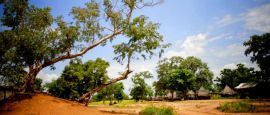With Omdurman and Bahri, Khartoum forms Sudan’s unusual 'three-towns capital'. Among the tourist attractions are Omdurman’s camel market and the Arab souk. Particularly noteworthy from a historical and artistic viewpoint is the well-organised National Museum, containing treasures dating back 6,000 years. The Khalifa's House Museum will reward those with an interest in Sudan's more recent history.
Sudan things to see and do
Tourist offices
Address: Khartoum, 10030, Sudan
Tel: +249 183 520 620
www.sudan-tourism.gov.sd
More widely associated with desert landscapes than coral reefs, Sudan has a burgeoning diving industry centred on the Red Sea’s Port Sudan from where scuba expeditions are led to various sites, including Jacque Cousteau’s underwater village and Sanganeb reef.
Port Sudan, Suakin and the Arous Tourist Village are three of the best centres from which to explore the country’s beautiful Red Sea coastline. If you can’t handle the heat head to Erkowit, which sits 1,200m (3,930ft) above sea level and is home to a beautiful resort offering exquisite panoramas and evergreen vegetation.
The southern provinces are characterised by green forests, open parkland, waterfalls and treeless swamps. The bird and animal life here flourishes, and includes elephant, black and white rhino, antelope, zebra, crocodile, hippo, and the almost extinct shoebill. The Gemmeiza Tourist Village, situated in the heart of East Equatoria, is considered of special interest, owing to the abundance of game in the area.
The extinct volcanoes of Jebel Marra, at more than 3,000m (10,000ft), are the highest point in the vast Darfur region of western Sudan. It is a sparsely populated area of outstanding scenic beauty and small traditional villages, waterfalls, volcanic lakes and a pleasant Mediterranean climate.
The Pyramids of Meroe are Sudan’s most iconic tourist site. The product of a culture quite different to that of Egypt, these brick-built and steep-sided pyramids sprout in groups of a dozen at a time, and there’s not a tourist tout offering souvenirs or camel rides in sight. Nearby are the archaeological sites of Naqa and Musawarat Es Sufra, which are worthy of a detour.
One of the largest ancient temple complexes in Sudan, Musawarat is thought to have been a pilgrimage site. Modern pilgrims can wander the columns of the Great Enclosure to study the carved walls depicting the animals that once inhabited the region. Also worth visiting are the engraving of the marriage room, and the elephant stables.
Covering 6,475 sq km (2,500 sq miles) southeast of Khartoum on the Ethiopian border, Dinder National Park is one of the largest in Africa. Providing homes for 27 species of large mammal including big cats and giraffe, it also provides habitats for a large variety of birdlife flying between Europe and Africa including pelican, kingfisher and the beautiful crown crane.
The now deserted Nile city of Old Dongola, which sits 80km (49 miles) from modern Dongola, represents one of Sudan’s premier archaeological sites. An important medieval Christian city, the remains include those of a dozen churches, though the most prominent survivor is the large Throne Hall, which was constructed between the 9th and 10th centuries.
The long straight roads of Omdurman lead to Sambat Bridge, a good place to view the sluggish and silt-laden waters of the reddish-brown Blue Nile converge with the clearer, lighter shades of the White Nile. Just south, the manmade wonder of the Gezira irrigation canals cover almost 9,000 sq km (3,500 sq miles) of land for cotton production.
Do you have any Feedback about this page?
© 2025 Columbus Travel Media Ltd. All rights reserved. No part of this site may be reproduced without our written permission, click here for information on Columbus Content Solutions.








 You know where
You know where